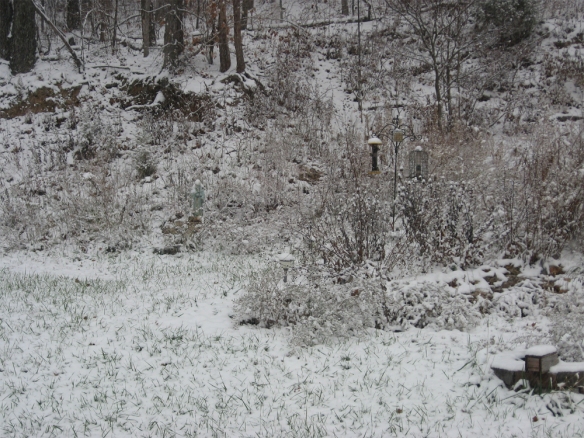
November Snow
Looks like I got my yard ready for winter just in the nick of time! I spent the afternoon yesterday hauling in my patio chairs, hose and yard ornaments, and putting the roosting box and winter feeders out and covering up my spigots. Today, snow is covering the yard!
It always makes me a little sad when I have to winterize the yard because it means the gardening season is over for the year and I’ll have to wait until next spring. But does that mean that nothing will happen in my yard until spring? … Not even close!
My yard is FULL of activity during the cold months. It is a great time to get to know your birds. Individuals, that are normally territorial during the nesting season, will come together in large flocks in search of food, water and shelter. If you provide one or all, they will definitely seek out your yard.
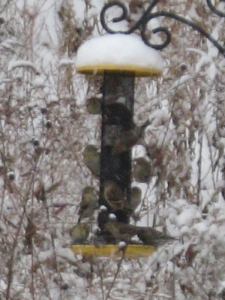
Nijer feeder with gold finches
In addition to my regular seed feeder and nijer feeder, there are several feeders that I put out during the winter months. The peanut feeder is quite popular, although make sure you buy the peanuts for birds (sold at pet or hardware stores), not the kind meant for people. All of the salt and seasoning isn’t really good for the birds. The suet feeders are also popular. The rich, high calorie suet cakes help the birds pack on fat to stay warm on those cold winter nights. For my non-seed eaters, such as my bluebirds, robins and mockingbirds, I put out raisins and dried mealworms in a tray feeder. Make sure you put food out regularly and eventually, you may have a couple bolder birds peering into your windows when the food is running a little low! They know who is feeding them! 🙂
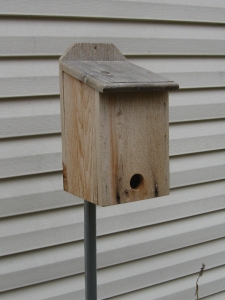
A roosting box has the hole at the bottom in order to retain heat. There are also perches inside the box for multiple birds.
Providing shelter is another way to attract birds and other critters to your yard. Leave those nestboxes up, or better yet, invest in a roosting box or two. Birds will seek these out to get out of the elements. The easiest way to provide shelter if you don’t want to spend the money on boxes (or in addition to the boxes) is to not cut your plants back until spring. Doing so will provide shelter for all kinds of creatures, not just birds.
The final thing to provide in your yard, if you can, is water. Believe it or not, water is hard to come by during winter, especially when everything is frozen, and birds still need to drink and bathe in order to stay healthy. I have a pond that takes a little longer to freeze over or there are heaters specially made for bird baths.
Providing any or all of these things will ensure that you have plenty of visitors in your yard. And the best part about it is, you can watch them all from the comfort of your toasty warm home! Just keep those binoculars and guide books handy!
Below is a list of birds that have visited my yard during the winter. What birds or critters have visited your yard?
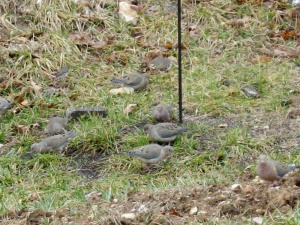 Mourning Doves. These brown doves with black spots on their backs usually arrive in small groups. I usually have about a dozen or so. They like to feed on the ground under the feeders or on a low platform feeder, so I usually throw some seed around on the ground for them. You can see these doves year-round. Mourning Doves. These brown doves with black spots on their backs usually arrive in small groups. I usually have about a dozen or so. They like to feed on the ground under the feeders or on a low platform feeder, so I usually throw some seed around on the ground for them. You can see these doves year-round. |
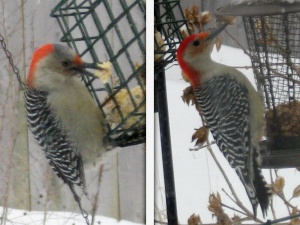 Red-bellied Woodpeckers. They are named for the pink area of feathers on their bellies just above the tail (trust me on this, I just didn’t capture that on the photos). The one on the left is a female. Notice how the red stripe starts further back on her head (reminds me of a receding hair-line). The one on the right is a male. His stripe runs all the way over his head. These are medium-sized woodpeckers and they love the peanuts and the suet, although you will also see them at the seed feeder. They live in the area year-round. Red-bellied Woodpeckers. They are named for the pink area of feathers on their bellies just above the tail (trust me on this, I just didn’t capture that on the photos). The one on the left is a female. Notice how the red stripe starts further back on her head (reminds me of a receding hair-line). The one on the right is a male. His stripe runs all the way over his head. These are medium-sized woodpeckers and they love the peanuts and the suet, although you will also see them at the seed feeder. They live in the area year-round. |
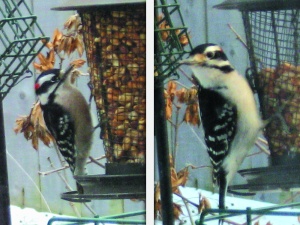 Downy Woodpecker (left). Hairy Woodpecker (right). It took me awhile to figure out at a glance which bird was which. Their coloring is very similar, but as you can see, there is a size difference. The Downy is our smallest woodpecker and fairly common at the feeders. The Hairy is larger (he’s actually turned slightly as well, so you’re not getting the full size difference) and has a longer bill (another thing you’re not seeing clearly from the photo). The Hairy (at least mine are) are a bit more camera shy. These are both males. Notice the red spot on the back of the Downy’s head? The males in both species will have this. The females in both species are lacking the red. They love the peanuts and the suet, but will also eat regular seed. Both of these woodpeckers live in the area year-round. Downy Woodpecker (left). Hairy Woodpecker (right). It took me awhile to figure out at a glance which bird was which. Their coloring is very similar, but as you can see, there is a size difference. The Downy is our smallest woodpecker and fairly common at the feeders. The Hairy is larger (he’s actually turned slightly as well, so you’re not getting the full size difference) and has a longer bill (another thing you’re not seeing clearly from the photo). The Hairy (at least mine are) are a bit more camera shy. These are both males. Notice the red spot on the back of the Downy’s head? The males in both species will have this. The females in both species are lacking the red. They love the peanuts and the suet, but will also eat regular seed. Both of these woodpeckers live in the area year-round. |
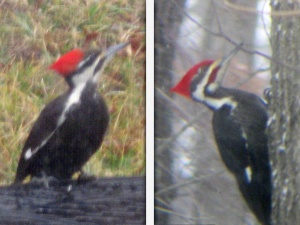 Pileated Woodpecker. These crow-sized birds are our largest woodpeckers. These photos are not very good, but I lucked out. These are shy woodpeckers that like to keep to the woods. One pair will have a territory that covers a very large area. Even though they live in the area all year, I only see them occasionally. The photo on the left is of a female that happened to visit my suet feeder a couple of winters ago. The one on the right is a male that dropped by last year. Notice the red hood on the female starts further back on her head? Also, she is lacking the red on her mustache. These birds don’t usually visit my feeders, but friends of mine who have more old growth trees around their homes say they are more frequent visitors at their suet feeders. Pileated Woodpecker. These crow-sized birds are our largest woodpeckers. These photos are not very good, but I lucked out. These are shy woodpeckers that like to keep to the woods. One pair will have a territory that covers a very large area. Even though they live in the area all year, I only see them occasionally. The photo on the left is of a female that happened to visit my suet feeder a couple of winters ago. The one on the right is a male that dropped by last year. Notice the red hood on the female starts further back on her head? Also, she is lacking the red on her mustache. These birds don’t usually visit my feeders, but friends of mine who have more old growth trees around their homes say they are more frequent visitors at their suet feeders. |
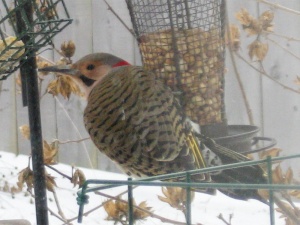 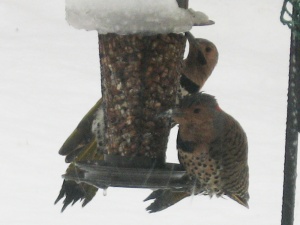 This is a Northern Flicker. Of all the woodpeckers, this is the one you would most likely see on the ground. In the summer, they spend their time turning over rocks and peaking around fallen logs looking for their favorite food…beetles and carpenter ants! An easy way to identify them is to look for the red V on the back of their heads. You will also see the yellow on the underside of their wings when they fly. This is a Northern Flicker. Of all the woodpeckers, this is the one you would most likely see on the ground. In the summer, they spend their time turning over rocks and peaking around fallen logs looking for their favorite food…beetles and carpenter ants! An easy way to identify them is to look for the red V on the back of their heads. You will also see the yellow on the underside of their wings when they fly.
Here is another photo of the Northern Flickers. The one behind the feeder is a male. The one in the front is a female. An easy way to tell the difference… the male has a mustache and the female does not. They love the peanuts and the suet. They live in the area year-round. |
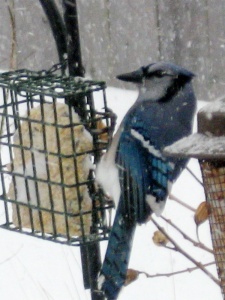 Blue Jay. This bird has a reputation for being noisy and often a bully at the feeders, but they play an important role. Many birds rely on the blue jay to alert them to danger. Blue Jays have also been known to harass predators until they leave. I personally enjoy these colorful birds. You can see them year-round in Missouri. They especially love the peanuts and the suet. Blue Jay. This bird has a reputation for being noisy and often a bully at the feeders, but they play an important role. Many birds rely on the blue jay to alert them to danger. Blue Jays have also been known to harass predators until they leave. I personally enjoy these colorful birds. You can see them year-round in Missouri. They especially love the peanuts and the suet. |
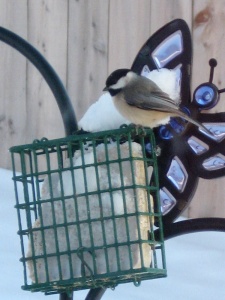 Chickadee. These little birds are chattery and full of spunk. They are often some of the first birds at a feeder and are not shy at all. They are usually chattering around me just out of reach when I’m filling the feeders. You can see them year-round in Missouri. They will come to the regular seed feeder as well as the peanut and suet feeders. Chickadee. These little birds are chattery and full of spunk. They are often some of the first birds at a feeder and are not shy at all. They are usually chattering around me just out of reach when I’m filling the feeders. You can see them year-round in Missouri. They will come to the regular seed feeder as well as the peanut and suet feeders. |
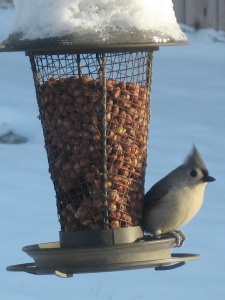 Tufted Titmouse. This cute little guy is related to the Chickadee. They too, are not shy and are often the first to the feeders. They will sit in the trees calling “Peter, Peter, Peter”. You can see them year-round in Missouri. They will come to the regular seed feeder, the peanut and the suet feeders. They also enjoy the mealworms that I occasionally put out. Tufted Titmouse. This cute little guy is related to the Chickadee. They too, are not shy and are often the first to the feeders. They will sit in the trees calling “Peter, Peter, Peter”. You can see them year-round in Missouri. They will come to the regular seed feeder, the peanut and the suet feeders. They also enjoy the mealworms that I occasionally put out. |
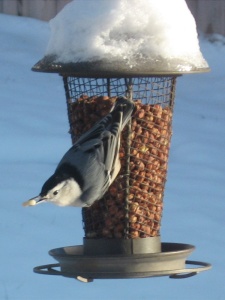 White-breasted Nuthatch. This handsome little guy can often be seen going down the trunk of a tree head-first like it’s doing here on the feeder. They have really strong feet and special neck muscles that allow them to remain in this position. They especially love the peanuts and suet, but will also visit the seed feeder. You can see them in Missouri year-round. White-breasted Nuthatch. This handsome little guy can often be seen going down the trunk of a tree head-first like it’s doing here on the feeder. They have really strong feet and special neck muscles that allow them to remain in this position. They especially love the peanuts and suet, but will also visit the seed feeder. You can see them in Missouri year-round. |
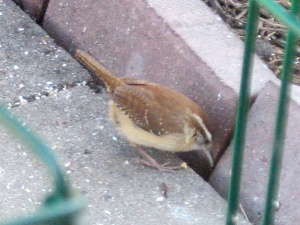 Carolina Wren. This brown little bird darts around on the ground searching for insects in the warm seasons or bits of suet or other food that the other birds dropped in the winter. This wren stays year-round in Missouri. An easy way to distinguish the Carolina Wren from the House Wren is by the white stripe above its eye. It will visit the seed, peanut and suet feeders. Carolina Wren. This brown little bird darts around on the ground searching for insects in the warm seasons or bits of suet or other food that the other birds dropped in the winter. This wren stays year-round in Missouri. An easy way to distinguish the Carolina Wren from the House Wren is by the white stripe above its eye. It will visit the seed, peanut and suet feeders. |
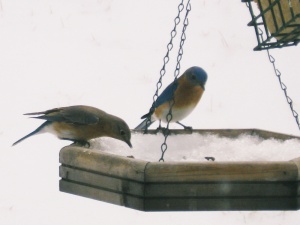 Eastern Bluebird. This is Missouri’s state bird. Oftentimes, when I mention Bluebirds, people think I’m talking about Blue Jays. That is not the case. These are gentle little birds that are from the Thrush family and are actually related to Robins. They are mainly insect eaters, but will eat berries or suet during the winter. They also enjoy the peanuts. Mine don’t tend to eat the mealworms I put out, although other people say that their bluebirds can’t get enough mealworms. My bluebirds hang around the area year-round. The female on the left is reaching for a raisin. She is not as bright of a blue as the male on the right. Eastern Bluebird. This is Missouri’s state bird. Oftentimes, when I mention Bluebirds, people think I’m talking about Blue Jays. That is not the case. These are gentle little birds that are from the Thrush family and are actually related to Robins. They are mainly insect eaters, but will eat berries or suet during the winter. They also enjoy the peanuts. Mine don’t tend to eat the mealworms I put out, although other people say that their bluebirds can’t get enough mealworms. My bluebirds hang around the area year-round. The female on the left is reaching for a raisin. She is not as bright of a blue as the male on the right. |
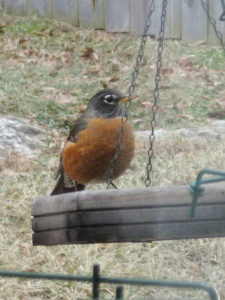 American Robin. I think most people are familiar with this bird, although most people don’t know that Robins hang around Missouri year-round. Robins are also insect-eaters, but will eat berries during the winter. I’ve only seen them eat the raisins at my feeders. American Robin. I think most people are familiar with this bird, although most people don’t know that Robins hang around Missouri year-round. Robins are also insect-eaters, but will eat berries during the winter. I’ve only seen them eat the raisins at my feeders. |
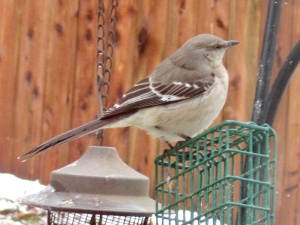 Northern Mockingbird. This gray bird with white bands on its wings is quite the vocalist. Mockingbirds have the ability to mimic other birds’ songs. You can often hear them singing very loudly from a tree EARLY in the morning. They are also here year-round. They are insect-eaters, but switch to berries in the winter. They only eat the raisins at my feeders. Northern Mockingbird. This gray bird with white bands on its wings is quite the vocalist. Mockingbirds have the ability to mimic other birds’ songs. You can often hear them singing very loudly from a tree EARLY in the morning. They are also here year-round. They are insect-eaters, but switch to berries in the winter. They only eat the raisins at my feeders. |
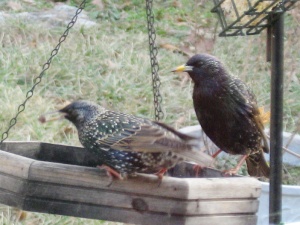 European Starlings. These birds tend to be a nuisance at the feeders. They descend on the area in huge flocks and gobble up everything they can in a matter of minutes. I usually try to shoo them away, but tolerated them for the sake of the photo. They are an exotic species introduced to New York in the 1890s and have greatly increased their numbers and have spread across much of the United States. They can be bullies at the feeders, but are easily frightened. They’re actually quite beautiful. At first glance, all you see is a black bird with a yellow beak. But if you look closely, their feathers are speckled and have bits of green in the black. They’re fun to watch, but if you are trying to help our native birds, they can be a hassle. They are here year-round. European Starlings. These birds tend to be a nuisance at the feeders. They descend on the area in huge flocks and gobble up everything they can in a matter of minutes. I usually try to shoo them away, but tolerated them for the sake of the photo. They are an exotic species introduced to New York in the 1890s and have greatly increased their numbers and have spread across much of the United States. They can be bullies at the feeders, but are easily frightened. They’re actually quite beautiful. At first glance, all you see is a black bird with a yellow beak. But if you look closely, their feathers are speckled and have bits of green in the black. They’re fun to watch, but if you are trying to help our native birds, they can be a hassle. They are here year-round. |
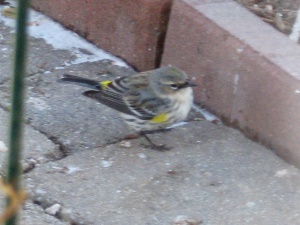 Yellow-rumped Warbler. This particular warbler winters here in Missouri, but will fly north during the summer months. You can recognize this bird by the yellow underneath its wings and on its back just above the tail. It’s also called “Butter-butt”. I’m serious, that’s what the guidebook says! They’re mainly ground feeders but will eat from the peanut feeder. It likes the suet, but it can’t hang on the suet feeder. Yellow-rumped Warbler. This particular warbler winters here in Missouri, but will fly north during the summer months. You can recognize this bird by the yellow underneath its wings and on its back just above the tail. It’s also called “Butter-butt”. I’m serious, that’s what the guidebook says! They’re mainly ground feeders but will eat from the peanut feeder. It likes the suet, but it can’t hang on the suet feeder. |
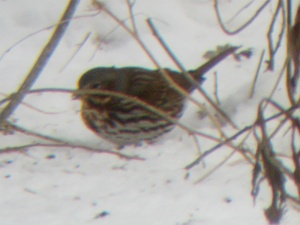 Fox Sparrow. The different species of the Sparrow family are more difficult to ID than some of the other birds. This sparrow is larger than the other sparrows and has a heavily streaked belly. This isn’t the best photo (I actually had to take it through the binoculars!) It has a redder brown on it than some of our sparrows and it has a gray head. It’s a ground feeder and you can often see it scratching like a chicken. This is a winter visitor in Missouri. Fox Sparrow. The different species of the Sparrow family are more difficult to ID than some of the other birds. This sparrow is larger than the other sparrows and has a heavily streaked belly. This isn’t the best photo (I actually had to take it through the binoculars!) It has a redder brown on it than some of our sparrows and it has a gray head. It’s a ground feeder and you can often see it scratching like a chicken. This is a winter visitor in Missouri. |
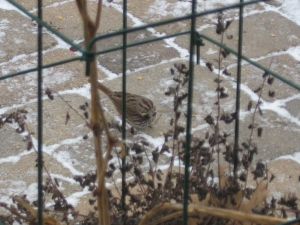 Song Sparrow. This sparrow is much smaller than the Fox Sparrow. It doesn’t have the reddish brown, just regular brown. And it has the stripes on its head instead of the solid gray. It too has a heavily striped belly that comes together in a spot on its chest. It’s a ground feeder and likes to search for seed and suet that has fallen from the feeders. This is a year-round resident for much of Missouri and a winter visitor for the south-western part of the state. Song Sparrow. This sparrow is much smaller than the Fox Sparrow. It doesn’t have the reddish brown, just regular brown. And it has the stripes on its head instead of the solid gray. It too has a heavily striped belly that comes together in a spot on its chest. It’s a ground feeder and likes to search for seed and suet that has fallen from the feeders. This is a year-round resident for much of Missouri and a winter visitor for the south-western part of the state. |
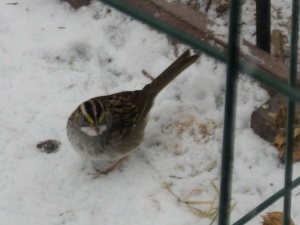 White-throated Sparrow. This sparrow is easier to identify. Just look for the white throat! Also, (it’s a little difficult to see in this photo) it has yellow stripes just above the eyes. This too is a ground feeder but it will visit the seed and peanut feeders. You can see it here in Missouri during the winter months. White-throated Sparrow. This sparrow is easier to identify. Just look for the white throat! Also, (it’s a little difficult to see in this photo) it has yellow stripes just above the eyes. This too is a ground feeder but it will visit the seed and peanut feeders. You can see it here in Missouri during the winter months. |
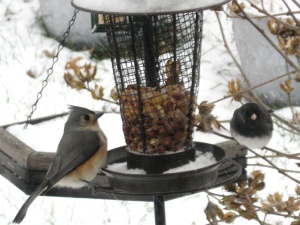 Dark-eyed Junco (right). The little gray and white bird on the right is also in our native Sparrow family. They are winter visitors here in Missouri. I usually look for them to come or go when the seasons change. They are normally ground-feeders but can occasionally be seen visiting the seed and peanut feeders. Dark-eyed Junco (right). The little gray and white bird on the right is also in our native Sparrow family. They are winter visitors here in Missouri. I usually look for them to come or go when the seasons change. They are normally ground-feeders but can occasionally be seen visiting the seed and peanut feeders. |
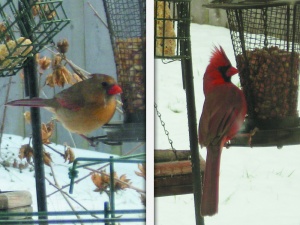 Northern Cardinal. Everybody in St. Louis should recognize this bird! Cardinals are members of the Finch family and are mainly seed eaters. They do however enjoy the peanuts and will occasionally eat the raisins that I put out. The one on the left is a female. She’s not as red as the male on the right. They are in Missouri year-round. Northern Cardinal. Everybody in St. Louis should recognize this bird! Cardinals are members of the Finch family and are mainly seed eaters. They do however enjoy the peanuts and will occasionally eat the raisins that I put out. The one on the left is a female. She’s not as red as the male on the right. They are in Missouri year-round. |
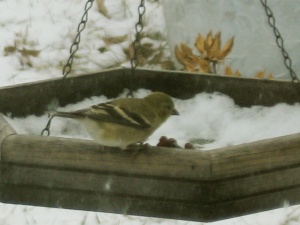 American Goldfinch. This little yellow bird is a bit duller in the winter than it is in the summer with the males more closely resembling the females in color. During the summer months, the males sport very bright yellow feathers with a black cap on its forehead. These birds like to cling to the nijer feeder, but will also visit the regular seed feeder. They are here year-round. American Goldfinch. This little yellow bird is a bit duller in the winter than it is in the summer with the males more closely resembling the females in color. During the summer months, the males sport very bright yellow feathers with a black cap on its forehead. These birds like to cling to the nijer feeder, but will also visit the regular seed feeder. They are here year-round. |
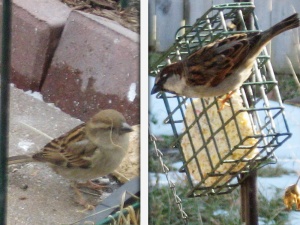 House (or English) Sparrow. This bird is actually not related to our native sparrows. In fact, it’s more closely related to finches, but not in the same family. This bird was introduced to New York in 1850 and has spread throughout the United States. Unlike the European Starlings, these birds know how to share at the feeders, so I generally let them be during the winter months. They are aggressive about nest sites though and many of our native birds have declined from competition with Starlings and House Sparrows. Neither of those two birds are protected in the United States and it is best to discourage them from evicting our native birds. I’ve personally had problems with them evicting my bluebirds (a native bird that had a population drop of 90% by the 1970s due to severe winters and nest competition with House Sparrows and Starlings). The female on the left looks much different from the male on the right. The male will have a black face mask and bib. These are year-round residents. They are generally ground feeders, but will visit the seed, suet and peanut feeders. House (or English) Sparrow. This bird is actually not related to our native sparrows. In fact, it’s more closely related to finches, but not in the same family. This bird was introduced to New York in 1850 and has spread throughout the United States. Unlike the European Starlings, these birds know how to share at the feeders, so I generally let them be during the winter months. They are aggressive about nest sites though and many of our native birds have declined from competition with Starlings and House Sparrows. Neither of those two birds are protected in the United States and it is best to discourage them from evicting our native birds. I’ve personally had problems with them evicting my bluebirds (a native bird that had a population drop of 90% by the 1970s due to severe winters and nest competition with House Sparrows and Starlings). The female on the left looks much different from the male on the right. The male will have a black face mask and bib. These are year-round residents. They are generally ground feeders, but will visit the seed, suet and peanut feeders. |
Pine Siskins and Purple Finches are also frequent visitors to my feeders during the cold months, but unfortunately, I don’t have any photos of them.
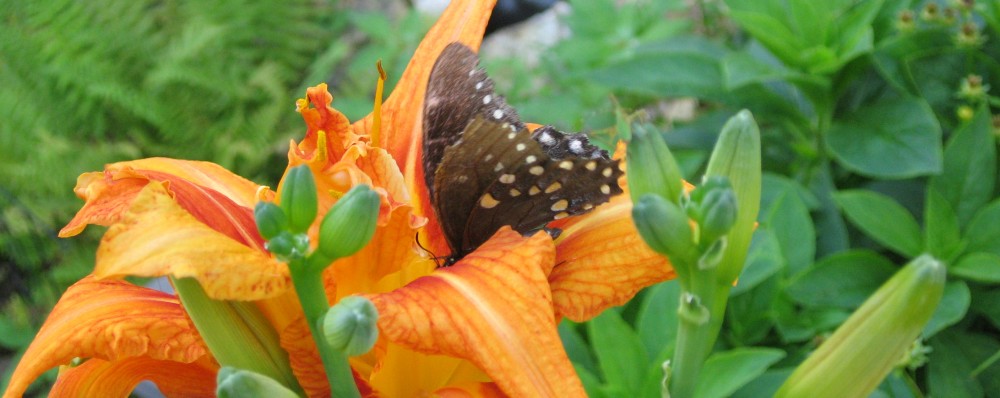
Wow do you have loads of birds of all sizes, shapes and colors…how wonderful
LikeLiked by 1 person
I do enjoy it. They brighten up my winters. 🙂
LikeLike
I do enjoy it. They brighten up my winters. 🙂
LikeLike
What a variety… I love my bird friends
LikeLiked by 1 person
Wonderful site and a lot of fun critters!
LikeLike
Thanks! 🙂
LikeLike